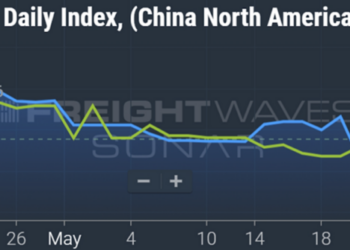San Diego-based global logistics technology company Tag-N-Trac recently unveiled its suite of updated IoT devices that include low-cost, disposable smart labels and tags. Venu Gutlapalli, CEO and co-founder at Tag-N-Trac, spoke with FreightWaves about how the devices and the Relativity technology platform work.
The process begins with the 5G cellular- and Bluetooth technology-integrated smart labels and tags, which are used in supply chain asset tracking systems and can locate and track shipments both in warehouse and in transit. The tags also report locations and conditions in real time from pallet level to SKU level and throughout the life cycle of a multimodal shipment. Tag-N-Trac gateways both within the trailer and warehouse are then used to provide the tracking and location information that feeds into the Relativity platform. Customers who have existing infrastructure like compatible Wi-Fi routers in their warehouses can integrate that information from the Bluetooth smart labels.
For Gutlapalli, the Relativity platform and device-agnostic approach allow greater flexibility, as many larger warehouses and transportation providers have existing infrastructure. This mindset also extends to the disposable smart labels, where the carrier or warehouse can create and print its own custom information on the underlying smart label.
Gutlapalli notes one benefit of the disposable smart labels is that they’re backward-compatible.
“What it means is that you don’t need to change your SOP,” he said. “Because traditionally you’re printing on a paper label, a bunch of bar codes which forms basic metadata for a given shipment. If I try to bring in a technology that says to do something else, then you have to change all your standard operating procedures.”
This means the Tag-N-Trac label is a smart label that combines all the bar code metadata into one data source, compared to traditional labels where data isn’t centralized and is instead spread among multiple bar codes.
Although the smart labels are disposable, Gutlapalli highlighted their durability, with batteries lasting three to six months depending on the product.
Pull vs. push data acquisition method
The company notes that an important differentiator between existing hardware tracking systems like RFID or traditional bar codes is that these are passive systems that still require someone physically scanning the device. These systems involve readers that then require the data to be pulled into another system, or queried.
Tag-N-Trac touts its push method: Its devices proactively send telematics data without the need for scanning. “All you need to do is capture the data through Tag-N-Trac warehouse Gateways or through infrastructure you already have,” said Gutlapalli. For a warehouse, this could mean using the existing Wi-Fi routers to pick up the bluetooth signals, whose direction-finding capabilities allow the tech-enabled smart labels’ to be triangulated with enough precision to know the pallet’s location within stacks of other items.
For shippers, brokers or carriers, the same push method can digitize their less-than-truckload shipment state and location to provide updates and geofencing alerts. An LTL shipment pulls into a facility’s property geofence, and the 5G cellular-enabled smart label provides a tracking update that the shipment has arrived. Once the trailer backs into a dock, the smaller Bluetooth-enabled, battery-powered, printable label provides a secondary status of pallet count within the LTL, indicating that the complete LTL shipment is in the dock. For warehouses and shippers, after the product is unloaded, the same printable label transitions to the final state noting the order status as “delivered.”
“Because every Bluetooth label is transmitting, ‘Hey, I’m here. This is my angle of transmit to you,’ the infrastructure is now triangulating on every pallet.” Gutlapalli adds that by using four receivers picking up the angled Bluetooth status updates, the platform can determine the exact location within the aisle and row in a warehouse to within a meter.
This visibility also extends to finding “lost-in-transit” shipments. Tag-n-Trac’s labels pushing out status updates create a crowdsourcing effect, where different labels assigned to other carriers can provide an extra layer of checks for missing pallets. LTL shipments face additional pressures due to multiple loads of combined or partial pallets which can belong to different customers. “With shippers and carriers, even if the shipper isn’t on board yet, the carrier now knows because they are able to get these things through the infrastructure or the smartphone or the 5G cellular label that they put on a given shipment.”
Multilevel shipment metadata hierarchy
The Tag-N-Trac devices begin with shipping label bar codes, which is the first step in their metadata mapping. The traditional fulfillment purchase order consists of a certain number of pallets carrying a packing list of different SKU IDs and crate IDs. This hierarchy of data for each pallet is then mapped to a unique QR code on the smart label. This data is combined with the source address and destination addresses, and provides automation for both outbound scans at the source depot and inbound scans at the receiving depot.
The ultimate goal is to create an end-to-end supply chain visibility solution, reducing enterprises’ need for multiple data aggregation platforms. Smart labels also eliminate the added hassle of requiring customers to ship back their nondisposable hardware tracking devices. The combination of the Tag-N-Trac Relativity platform along with the IoT 5G cellular and bluetooth smart labels each communicating with one another, paired with geofencing and condition monitoring, allows unparalleled shipment intelligence and process automation.
To learn more about Tag-N-Trac, visit tagntrac.com.
The post How smart labels are improving supply chain intelligence appeared first on FreightWaves.













